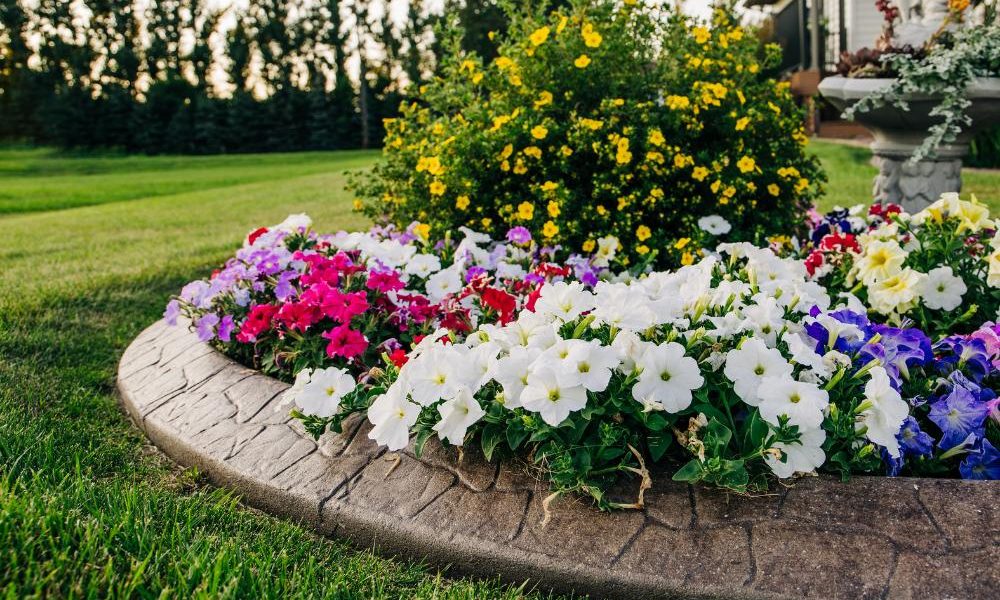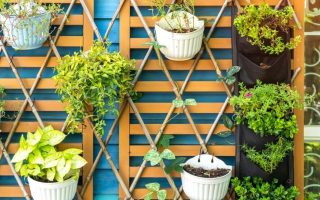Imagine transforming a bland, lifeless wall into a vibrant tapestry of greenery, flowers, and even edible plants. Vertical gardens offer a way to beautify your home while making the most of your space. They can add curb appeal, improve air quality, and create a sense of tranquility. In this guide, we’ll explore the world of vertical gardens, from their benefits to practical tips for creating your own stunning vertical garden.
The Beauty and Benefits of Vertical Gardens
Vertical gardens, also known as living walls or green walls, are an innovative way to incorporate nature into urban and suburban environments. These gardens grow upward, using various structures to support plants vertically.
Enhancing Curb Appeal
A well-designed vertical garden can transform the exterior of your home. It creates a striking visual impact, making your home stand out in the neighborhood. Flora Grubb, a renowned landscape designer, notes, “Vertical gardens are a fantastic way to add drama and interest to a small space. They can be used to create privacy screens, green walls, or even edible gardens” .
Environmental Benefits
Vertical gardens are not just beautiful; they also offer significant environmental benefits. They help to insulate buildings, reducing energy costs by keeping interiors cooler in the summer and warmer in the winter. Rebecca Cole, a horticulturalist and author, explains, “Vertical gardens are not only beautiful, but they’re also functional. They can help to insulate buildings, reduce energy costs, and improve air quality” .
Improving Air Quality
Plants naturally filter the air, removing pollutants and releasing oxygen. By incorporating a vertical garden into your home’s exterior, you can enhance the air quality around your home. Patrick Blanc, the botanist who pioneered modern vertical gardening, states, “Vertical gardens are the future of urban greening. They allow us to bring nature into our cities and create beautiful, living walls that improve air quality, reduce noise pollution, and enhance our well-being” .
Designing Your Vertical Garden
Creating a vertical garden requires planning and creativity. Here are some key considerations to help you design a stunning and functional vertical garden.
Choosing the Right Location
Select a location that receives the appropriate amount of sunlight for the plants you intend to grow. Most vertical gardens thrive best on walls that receive partial to full sunlight. Consider the view from both inside and outside your home to maximize the visual impact.
Selecting Plants
When choosing plants for your vertical garden, think about the overall look you want to achieve. Mix textures, colors, and plant types to create a dynamic and eye-catching display. George Irwin, a landscape architect, says, “Vertical gardens offer endless design possibilities. You can use a variety of plants, textures, and colors to create a unique and eye-catching display” .
Some popular plants for vertical gardens include:
- Ferns: Great for adding lush greenery.
- Succulents: Low-maintenance and come in various shapes and colors.
- Herbs: Practical and aromatic, perfect for edible gardens.
- Flowers: Add bursts of color and fragrance.
Building the Structure
There are several ways to create the structure for your vertical garden:
- Pockets: Fabric pockets that hold soil and plants.
- Trellises: Support climbing plants and vines.
- Modular Panels: Pre-made panels that can be attached to walls.
- DIY Frames: Custom-built frames using wood, metal, or PVC.
Irrigation and Drainage
Proper irrigation is crucial for the success of your vertical garden. Drip irrigation systems are an efficient way to ensure that your plants receive consistent moisture. Additionally, ensure that your vertical garden has good drainage to prevent waterlogging and root rot.
Maintenance Tips for Vertical Gardens
Vertical gardens require regular maintenance to keep them healthy and beautiful. Here are some tips to help you maintain your vertical garden:
Regular Watering
Depending on the plants and the climate, you may need to water your vertical garden more frequently than traditional gardens. Automated drip irrigation systems can help simplify this task.
Pruning and Trimming
Keep your plants looking their best by regularly pruning and trimming them. This encourages healthy growth and prevents the garden from becoming overgrown.
Feeding
Fertilize your plants according to their needs. Slow-release fertilizers are a good option for vertical gardens, as they provide nutrients over a longer period.
Inspecting for Pests
Regularly inspect your vertical garden for pests and diseases. Early detection and treatment are key to preventing infestations from spreading.
Personal Experiences with Vertical Gardens
Incorporating a vertical garden into my home was one of the best decisions I’ve made for both aesthetic and practical reasons. The process of planning and building the garden was a creative outlet, and now it’s a beautiful focal point that never fails to impress visitors.
A Journey to a Greener Home
When I first started my vertical garden, I was unsure about which plants to choose. I began with a mix of ferns, succulents, and herbs. Over time, I added flowers for bursts of color. The transformation was incredible. Not only did the garden enhance the curb appeal of my home, but it also became a peaceful retreat where I could enjoy a cup of tea surrounded by nature.
Overcoming Challenges
One challenge I faced was ensuring proper irrigation. Initially, I struggled with overwatering and underwatering. Installing a drip irrigation system made a huge difference, providing consistent moisture and freeing me from the daily watering routine.
Continuous Learning
Maintaining a vertical garden is a continuous learning process. I’ve learned the importance of regular pruning to keep the garden looking neat and vibrant. I also discovered the joy of experimenting with different plants and arrangements, creating a living art piece that evolves with the seasons.
The Future of Vertical Gardens
Vertical gardens are more than just a trend; they represent a shift towards sustainable and aesthetically pleasing urban environments. As cities become more crowded and green spaces more limited, vertical gardens offer a solution that brings nature back into our daily lives.
Urban Greening
Vertical gardens are especially beneficial in urban areas, where space is limited. They can be installed on the sides of buildings, transforming gray, concrete structures into lush, green oases. This not only beautifies the city but also helps to mitigate the urban heat island effect by cooling the surrounding environment.
Residential Applications
Homeowners are increasingly recognizing the benefits of vertical gardens. They are a perfect solution for small yards or patios where traditional gardening space is limited. By growing upward, vertical gardens maximize space and create a stunning visual impact.
Sustainability and Innovation
Advances in technology and design continue to improve the functionality and sustainability of vertical gardens. From self-watering systems to innovative materials that enhance plant growth, the future of vertical gardens is bright and full of potential.
Conclusion
Vertical gardens are a fantastic way to enhance the curb appeal of your home while contributing to a greener, more sustainable environment. Whether you have a small balcony or a large yard, there’s a vertical garden solution that can transform your space. By choosing the right plants, designing an effective structure, and maintaining your garden with care, you can enjoy the beauty and benefits of vertical gardening for years to come.




